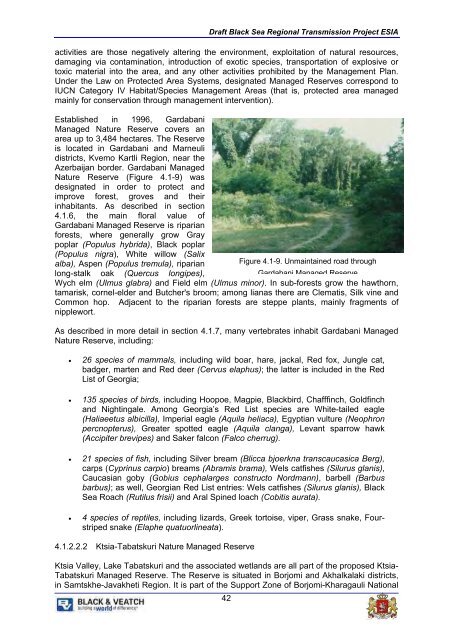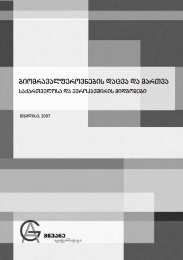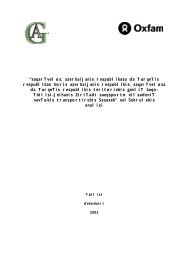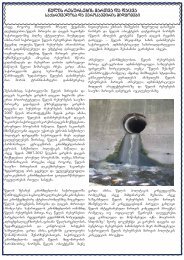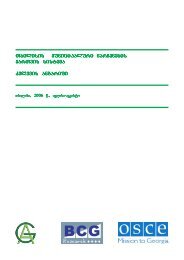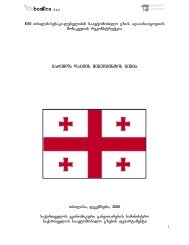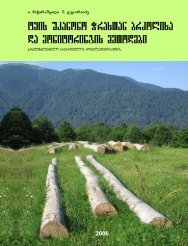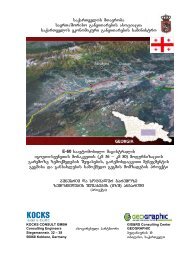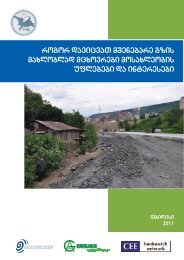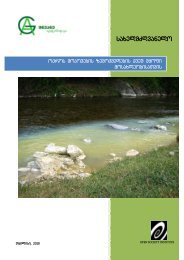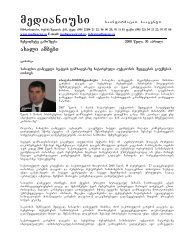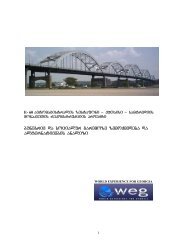Part I
Part I
Part I
You also want an ePaper? Increase the reach of your titles
YUMPU automatically turns print PDFs into web optimized ePapers that Google loves.
Draft Black Sea Regional Transmission Project ESIA<br />
activities are those negatively altering the environment, exploitation of natural resources,<br />
damaging via contamination, introduction of exotic species, transportation of explosive or<br />
toxic material into the area, and any other activities prohibited by the Management Plan.<br />
Under the Law on Protected Area Systems, designated Managed Reserves correspond to<br />
IUCN Category IV Habitat/Species Management Areas (that is, protected area managed<br />
mainly for conservation through management intervention).<br />
Established in 1996, Gardabani<br />
Managed Nature Reserve covers an<br />
area up to 3,484 hectares. The Reserve<br />
is located in Gardabani and Marneuli<br />
districts, Kvemo Kartli Region, near the<br />
Azerbaijan border. Gardabani Managed<br />
Nature Reserve (Figure 4.1-9) was<br />
designated in order to protect and<br />
improve forest, groves and their<br />
inhabitants. As described in section<br />
4.1.6, the main floral value of<br />
Gardabani Managed Reserve is riparian<br />
forests, where generally grow Gray<br />
poplar (Populus hybrida), Black poplar<br />
(Populus nigra), White willow (Salix<br />
alba), Aspen (Populus tremula), riparian Figure 4.1-9. Unmaintained road through<br />
long-stalk oak (Quercus longipes),<br />
Gardabani Managed Reserve<br />
Wych elm (Ulmus glabra) and Field elm (Ulmus minor). In sub-forests grow the hawthorn,<br />
tamarisk, cornel-elder and Butcher's broom; among lianas there are Clematis, Silk vine and<br />
Common hop. Adjacent to the riparian forests are steppe plants, mainly fragments of<br />
nipplewort.<br />
As described in more detail in section 4.1.7, many vertebrates inhabit Gardabani Managed<br />
Nature Reserve, including:<br />
<br />
<br />
<br />
<br />
26 species of mammals, including wild boar, hare, jackal, Red fox, Jungle cat,<br />
badger, marten and Red deer (Cervus elaphus); the latter is included in the Red<br />
List of Georgia;<br />
135 species of birds, including Hoopoe, Magpie, Blackbird, Chafffinch, Goldfinch<br />
and Nightingale. Among Georgia’s Red List species are White-tailed eagle<br />
(Haliaeetus albicilla), Imperial eagle (Aquila heliaca), Egyptian vulture (Neophron<br />
percnopterus), Greater spotted eagle (Aquila clanga), Levant sparrow hawk<br />
(Accipiter brevipes) and Saker falcon (Falco cherrug).<br />
21 species of fish, including Silver bream (Blicca bjoerkna transcaucasica Berg),<br />
carps (Cyprinus carpio) breams (Abramis brama), Wels catfishes (Silurus glanis),<br />
Caucasian goby (Gobius cephalarges constructo Nordmann), barbell (Barbus<br />
barbus); as well, Georgian Red List entries: Wels catfishes (Silurus glanis), Black<br />
Sea Roach (Rutilus frisii) and Aral Spined loach (Cobitis aurata).<br />
4 species of reptiles, including lizards, Greek tortoise, viper, Grass snake, Fourstriped<br />
snake (Elaphe quatuorlineata).<br />
4.1.2.2.2 Ktsia-Tabatskuri Nature Managed Reserve<br />
Ktsia Valley, Lake Tabatskuri and the associated wetlands are all part of the proposed Ktsia-<br />
Tabatskuri Managed Reserve. The Reserve is situated in Borjomi and Akhalkalaki districts,<br />
in Samtskhe-Javakheti Region. It is part of the Support Zone of Borjomi-Kharagauli National<br />
42


